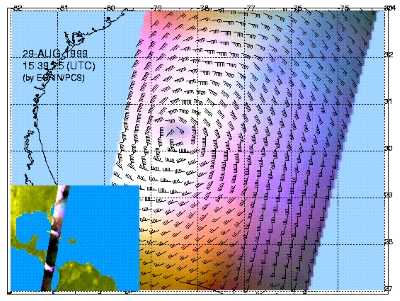Wind Scatterometer (WS)
Instrument Overview

The Wind Scatterometer (WS) was an instrument onboard the ERS-1 and ERS-2 missions.
The WS instrument was designed to measure wind over the oceans by measuring changes in radar backscatter caused by the wind. It obtained information on wind speed and direction at the sea surface for incorporation into models, global statistics and climatological datasets.
It operated by recording the change in radar reflectivity of the sea due to the perturbation of small ripples by the wind close to the surface. This was possible because the radar backscatter returned to the satellite was modified by wind-driven ripples on the ocean surface and, since the energy in these ripples increased with wind velocity, backscatter increased with wind velocity.
The WS worked in tandem with the Synthetic Aperture Radar (SAR) instrument in a configuration called the 'Active Microwave Instrument' (AMI). The AMI was operated in either SAR or Wind mode but could also operate in a combined mode - wind/wave mode which consisted of Scatterometer operations (Wind mode) interrupted every 30 seconds (roughly 200 km) by a couple of seconds of a short SAR operation in order to acquire small SAR images of roughly 6 x 6 km from which wave spectra could be derived.
The ERS-1 mission launched on 17 July 1991 and ended on 10 March 2000, ERS-2 was launched on 21 April 1995 and retired on 5 September 2011.
Data Description
All ERS SAR products, in accordance with ESA Earth Observation Data Policy, are freely available to registered users via FTP. Read more about the available products and the registration process which is required to access them:
- Scatterometer Surface Soil Moisture Time Series and Orbit product in High and Nominal Resolution
- Scatterometer High Resolution Ocean Wind field and Sea Ice probability
- Scatterometer Nominal Resolution back-scattering measurements, Ocean Wind field
Documentation
ERS Wind Scatterometer Technical Document:
- Products Specifications ERSE-GSEV-EOPG-RS-06-0002_ver2.5.pdf
- ATBD: RMA-SIC-011109.pdf
- ERS-1 full mission reprocessing report: IDEAS+-SER-IPF-REP-2992
Processor Releases
Read more about WS's Instrument processor releases
Cal/Val
The goal of WS (ERS) calibration and validation activities was to verify the accuracy and quality of data the instrument acquired. A Calibration / Validation plan, details of Calibration and Validation Activities are available.
Quality Control Reports
Quality Control is monitoring routinely the status of the spacecraft (payload and platform) and to check if the derived products meet the quality requirements along mission life-time. WS (ERS) Quality Control Reports are available regarding Products Availability, Cyclic Reports, ERS-2 Yaw Error Angle Monitoring - Weekly Reports, a Cyclone Archive and Telemetry Data.